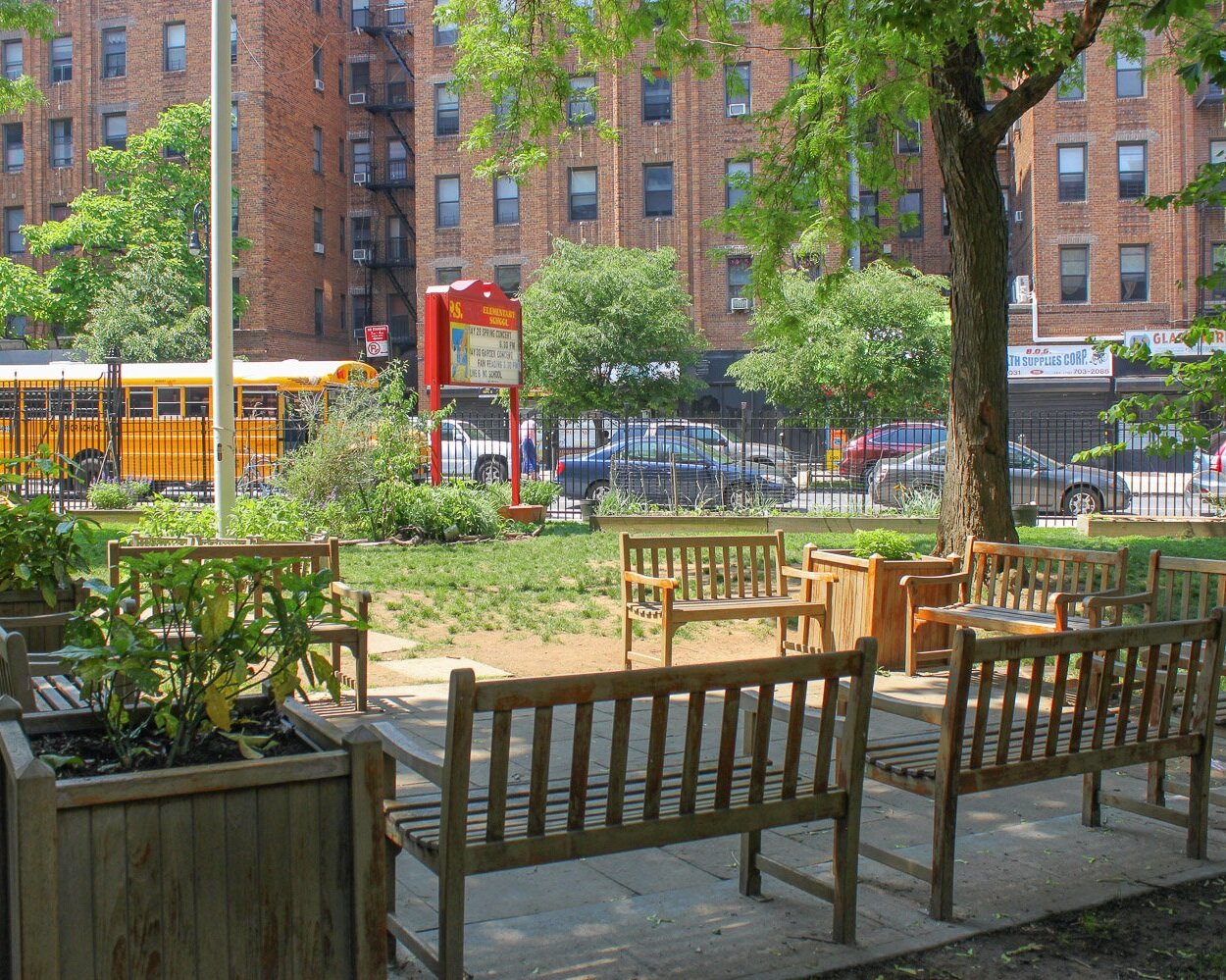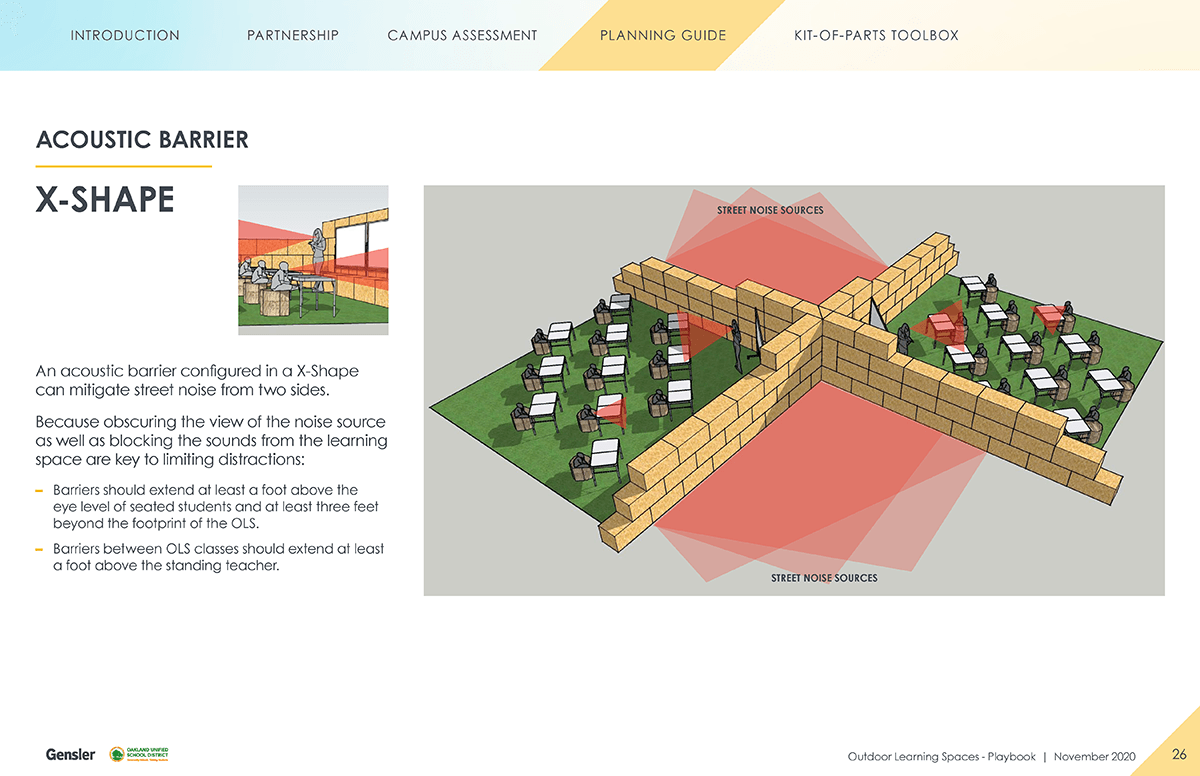Addressing Noise and Sound in Outdoor Learning Spaces
Time outdoors may include a variety of noises and noise levels. In addition to natural sounds, which can be beneficial (see the “Health Benefits of Nature and Being Outdoors” section in the Health Guidance chapter), there may also be distracting and potentially stressful noises such as those from freeway and street traffic, construction, lawn care, air traffic, and other local activity. With multiple classes sharing outdoor spaces, there may also be interfering noise between classes. A unique complicating factor during COVID-19 is the challenge of hearing each other speak when children and teachers are physically distanced and/or wearing masks.
The main goal of the strategies described in this document is to help schools that have challenges related to noise create comfortable outdoor learning spaces that allow students and teachers to hear one another clearly without having to raise their voices.
Low and No-Cost Strategies
Consider locating outdoor classrooms in spots that are shielded from street noise by buildings or other existing barriers.
Increase the distance between bothersome sound and receiver by moving outdoor learning spaces away from busy roads and, if possible, at least 45 feet away from other student cohorts. This will decrease background noise level in the “classroom,” which in turn will improve the signal-to-noise ratio so the teacher will not have to speak as loudly. A 45-foot distance is predicted to decrease the voice level of someone speaking in a raised voice level (at a 3-foot distance) by more than 20 decibels.
Reduce unwanted sound between outdoor classrooms by orienting teachers’ backs to one another, as shown in Figure 1.
If noise levels vary throughout the day, adjust schedules so that outdoor learning does not happen at noisiest times.
Reduce sound at the source, perhaps, by implementing emergency COVID-19 noise ordinances near outdoor learning spaces.
Figure 1 (above): An acoustic barrier configured in a T-shape can mitigate street noise from one side. Click on image to view larger.
Moderate Investment Solutions
Place natural or manufactured shields between sound and receiver. The most effective is a “band shell” or “baseball backstop” configuration, which creates a sound shadow zone that reduces environmental noise intrusion into the area in the “shadow zone,” such as in Figure 2.
This can be accomplished with
plantings of tall, dense ornamental grasses, hedges, and shrubs
straw bales stacked between the teacher’s back and the source of noise, as in Figure 3
hugelkultur mounds or soil berm providing planting space, sound buffering, and screening unwanted views
foam/fabric panels enclosing the outdoor learning space and overhead (If fabric is within reach of students and staff, it should be laundered regularly.)
soft surfacing such as grass, mulch, or outdoor carpets underfoot
soft materials such as foam or fabric on adjacent building walls to reduce echoes and reverberation.
Figure 2 (above) and Figure 3 (below): An acoustic barrier configured in an H-shape or X-shape can mitigate street noise from two sides. Click on images to view larger.
Capital Investments for Longer Term Outdoor Learning Spaces
Concrete blocks or masonry walls can reduce sound by 10 decibels. Be sure to consult a licensed engineer. Other solid barrier materials such as wood, cement board, and so on, should have a minimum surface weight of 3 pounds per square foot and have no gaps or cracks between panels or at the base.
Find more information on Noise Elements here.
Strategies for Improving Hearing Within Cohorts
Seat students with hearing impairments closest to the teacher.
Check your local health guidelines for the current recommended spacing between people outdoors with or without masks and adjust as allowed. You can find your local health department here. For more on local health rules, see our resource, A Brief Guide to Local Health Rules.
Add physical devices such as these domes to each seat to help catch the sound. These are only recommended when students are seated in a semicircle, circle, or single row. Check current CDC guidelines to see if domes need to be individualized to each student or cleaned between use.
Consider localized, narrow-dispersion voice amplification devices and assistive listening technology especially for very noisy sites (near a highway or in an airport flight path). For the voice amplification devices, one that seems in alignment with the intent is the BeltBlaster Pro by AVAmplivox. The narrow dispersion loudspeakers would be line array loudspeakers, which are available from many vendors (e.g., Bose, JBL, and others). There would need to be some technical due diligence with respect to speaker layouts and orientation. The BeltBlaster device also has a volume control that would require adjusting by the users.
Understanding noise-related terminology
Signal-to-noise ratio
Signal-to-noise ratio (SNR or S/N) is a measure used in science and engineering that compares the level of a desired signal to the level of background noise. SNR is defined as the ratio between signal power and noise power. It is usually measured in decibels. A ratio greater than 1:1 indicates more signal than noise. In outdoor learning, “signal” refers to the teacher or student who is speaking and “noise” includes the interfering sounds from offsite and on-site sources such as freeway/traffic/street noise, construction and lawn care power tools, airplanes and airports, music, as well as sounds from other outdoor classrooms and from students playing on the playground.
Decibels and common sources of noise
An outdoor noise level above 65 decibels is considered problematic because it exceeds the volume of conversational speech. High-pitched sounds are easier to abate than low-pitched sounds.
Sound level meters with sufficient sensitivity (ANSI Type 2) are usually a few hundred dollars. While there are numerous sound level meter phone apps, those can be relatively insensitive under certain circumstances. However, they can be useful as a nontechnical “ballpark” measurement for measuring the sound level in your schoolyard.
dB NOISE SOURCE
90 Lawn mower within 20 feet
80 Average city noise near major roadway
70 Freeway traffic about 500 feet away
60 Conversational speech at a distance of 3 feet
If the perimeter of the schoolyard is exposed to regular roadway noises, mitigation may be needed, such as with soft vegetation along a fence.
Related Resources
Quieting: A Homeowner’s Practical Guide to Noise Control, pages 1-9
— U.S. Department of Commerce, National Bureau of Standards, Sound Section
Orange General Plan: Noise Element
— City of Orange, California
Reach out to local acoustic experts and engineers who will have the expertise to solve the most challenging noise issues.
CREDITS
This article was written by Ethan Salter, Salter Acoustics; Nancy Striniste, EarlySpace LLC; and Rhiannon Texara, Gensler.
It was reviewed by Christina Vassallo, MSN, FNP-BC and Sarah Gill, MPP
National COVID-19 Outdoor Learning Initiative
The National COVID-19 Outdoor Learning Initiative supports schools and districts around the country in their efforts to reopen safely and equitably using outdoor spaces as strategic, cost-effective solutions to increase physical distancing capacity onsite and provide access to abundant fresh air. The Initiative seeks to equitably improve learning, mental and physical health, and happiness for children and adults using an affordable, time-tested outdoor approach to keeping schools open during a pandemic.











